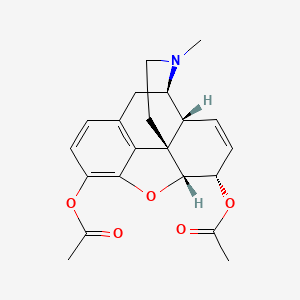NCBI Bookshelf. A service of the National Library of Medicine, National Institutes of Health.
LiverTox: Clinical and Research Information on Drug-Induced Liver Injury [Internet]. Bethesda (MD): National Institute of Diabetes and Digestive and Kidney Diseases; 2012-.

LiverTox: Clinical and Research Information on Drug-Induced Liver Injury [Internet].
Show detailsOVERVIEW
Introduction
Heroin and opium are potent opiates that are currently banned in the United States and considered drugs of abuse. Persons who actively use heroin or opium often have liver disease due to substance abuse (alcoholic liver injury) or injection drug use (chronic hepatitis B, D or C), but neither heroin nor opium have been convincingly linked to clinically apparent liver injury or worsening of a concurrent liver disease.
Background
Opium (o pee’ um) is a mixture of natural alkaloids derived from resin extracts from the seeds of the opium poppy, Papaver somniferum. The analgesic and mood altering effects of poppy extracts have been known for centuries and opium use has had profound effects on world history and many human lives. The natural opiates in opium include morphine, codeine and thebaine. Opium is typically taken by inhalation (opium pipe), but can also be taken orally.
Heroin (morphine diacetate) was developed in the 19th century as a derivative of morphine, the major alkaloid constituent of opium, and was initially thought to provide the potent analgesic effects without the euphoria and risk of psychological and physical dependency characteristic of opium. Heroin was the brand name for morphine diacetate and initially was sold over-the-counter as a cough suppressant. The abuse potential of heroin, however, rapidly became obvious and, by the 1920’s, heroin was the major drug of abuse in the United States, which led to its being made illegal and banned from clinical medicine. Both heroin and opium are potent agonists of the opiate receptors (predominantly the µ type receptor) which are found mostly in the central nervous system, but also in the lungs, heart, gastrointestinal tract and even on circulating white blood cells. Opium and heroin have many clinical effects, most strikingly euphoria, drowsiness, mental clouding and analgesia. While banned in the United States, heroin (known as its more correct chemical name of morphine diacetate) is available in other countries including the United Kingdom, but its use is severely restricted. The severe complications of heroin use are usually not due to its side effect profile, but to the unreliable sources, concentration and quality of the product.
Hepatotoxicity
Despite centuries of use and abuse, opium and heroin have not been convincingly linked to cases of clinically apparent liver injury. Persons who use heroin or opium illicitly often have an underlying liver disease, due to other substance abuse behaviors (alcoholic liver disease) or parenteral exposures due to injection drug use (chronic hepatitis B, C or D). There is little evidence that opium or heroin use worsens these underlying liver diseases.
Likelihood score, Heroin: E (unlikely cause of clinically apparent liver injury).
Opium is a mixture of natural alkaloids, the major active ingredients being morphine and codeine. Heroin is a derivative of morphine and has no opiate activity, but is rapidly metabolized in the body to morphine. Heroin is the former brand name for morphine diacetate, which is more lipid soluble than morphine, for which reason it tends to have a faster onset of action and heightened potency.
Likelihood score, Opium: E (unlikely cause of clinically apparent liver injury).
References on the safety and potential hepatotoxicity of opium and heroin are given in the Overview section of the Opioids.
Drug Class: Opioids
PRODUCT INFORMATION
REPRESENTATIVE TRADE NAMES
[None]
DRUG CLASS
Opioids
CHEMICAL FORMULAS AND STRUCTURES
| DRUG | CAS REGISTRY NO. | MOLECULAR FORMULA | STRUCTURE |
|---|---|---|---|
| Heroin | 561-27-3 | C21-H25-N-O5 |

|
| Opium | 8008-60-4 | Unspecified Mixture of natural alkaloids including morphine and codeine | No Structure |
- PubChem SubstanceRelated PubChem Substances
- Review Opioids.[LiverTox: Clinical and Researc...]Review Opioids.. LiverTox: Clinical and Research Information on Drug-Induced Liver Injury. 2012
- Review Drug abuse in Asia.[Bull Narc. 1986]Review Drug abuse in Asia.Suwanwela C, Poshyachinda V. Bull Narc. 1986 Jan-Jun; 38(1-2):41-53.
- Urinary excretion of morphine and codeine following the administration of single and multiple doses of opium preparations prescribed in Taiwan as "brown mixture".[J Anal Toxicol. 2006]Urinary excretion of morphine and codeine following the administration of single and multiple doses of opium preparations prescribed in Taiwan as "brown mixture".Liu HC, Ho HO, Liu RH, Yeh GC, Lin DL. J Anal Toxicol. 2006 May; 30(4):225-31.
- Review Confirmation of recent heroin abuse: Accepting the challenge.[Drug Test Anal. 2018]Review Confirmation of recent heroin abuse: Accepting the challenge.Maas A, Madea B, Hess C. Drug Test Anal. 2018 Jan; 10(1):54-71. Epub 2017 Sep 5.
- Drug-taking among Nigerian students at universities in the United States of America.[Bull Narc. 1987]Drug-taking among Nigerian students at universities in the United States of America.Achalu OE, Duncan DF. Bull Narc. 1987; 39(2):75-80.
- Heroin - LiverToxHeroin - LiverTox
Your browsing activity is empty.
Activity recording is turned off.
See more...